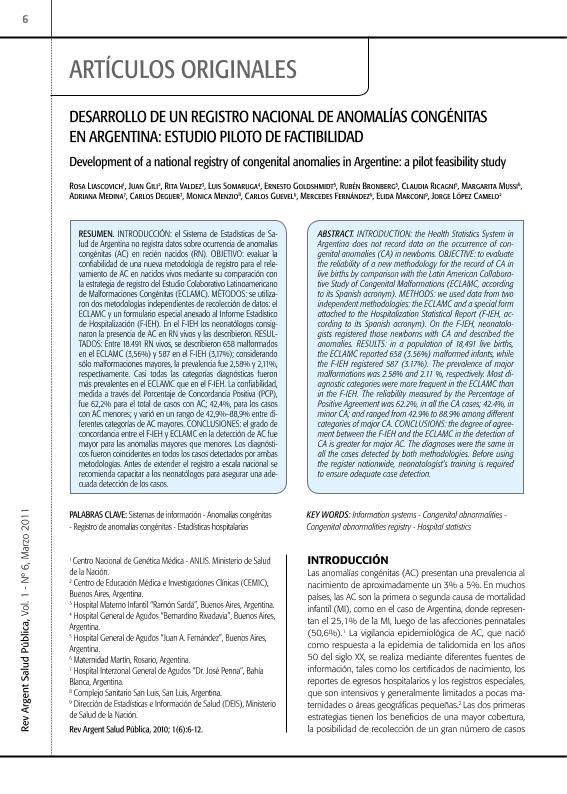Artículo
INTRODUCCIÓN: el Sistema de Estadísticas de Salud de Argentina no registra datos sobre ocurrencia de anomalías congénitas (AC) en recién nacidos (RN). OBJETIVO: evaluar la confiabilidad de una nueva metodología de registro para el relevamiento de AC en nacidos vivos mediante su comparación con la estrategia de registro del Estudio Colaborativo Latinoamericano de Malformaciones Congénitas (ECLAMC). MÉTODOS: se utilizaron dos metodologías independientes de recolección de datos: el ECLAMC y un formulario especial anexado al Informe Estadístico de Hospitalización (F-IEH). En el F-IEH los neonatólogos consignaron la presencia de AC en RN vivos y las describieron. RESULTADOS: Entre 18.491 RN vivos, se describieron 658 malformados en el ECLAMC (3,56%) y 587 en el F-IEH (3,17%); considerando sólo malformaciones mayores, la prevalencia fue 2,58% y 2,11%, respectivamente. Casi todas las categorías diagnósticas fueron más prevalentes en el ECLAMC que en el F-IEH. La confiabilidad, medida a través del Porcentaje de Concordancia Positiva (PCP), fue 62,2% para el total de casos con AC; 42,4%, para los casos con AC menores; y varió en un rango de 42,9%–88,9% entre diferentes categorías de AC mayores. CONCLUSIONES: el grado de concordancia entre el F-IEH y ECLAMC en la detección de AC fue mayor para las anomalías mayores que menores. Los diagnósticos fueron coincidentes en todos los casos detectados por ambas metodologías. Antes de extender el registro a escala nacional se recomienda capacitar a los neonatólogos para asegurar una adecuada detección de los casos. INTRODUCTION: the Health Statistics System in Argentina does not record data on the occurrence of congenital anomalies (CA) in newborns. OBJECTIVE: to evaluate the reliability of a new methodology for the record of CA in live births by comparison with the Latin American Collaborative Study of Congenital Malformations (ECLAMC, according to its Spanish acronym). METHODS: we used data from two independent methodologies: the ECLAMC and a special form attached to the Hospitalization Statistical Report (F-IEH, according to its Spanish acronym). On the F-IEH, neonatologists registered those newborns with CA and described the anomalies. RESULTS: in a population of 18,491 live births, the ECLAMC reported 658 (3.56%) malformed infants, while the F-IEH registered 587 (3.17%). The prevalence of major malformations was 2.58% and 2.11 %, respectively. Most diagnostic categories were more frequent in the ECLAMC than in the F-IEH. The reliability measured by the Percentage of Positive Agreement was 62.2%, in all the CA cases; 42.4%, in minor CA; and ranged from 42.9% to 88.9% among different categories of major CA. CONCLUSIONS: the degree of agreement between the F-IEH and the ECLAMC in the detection of CA is greater for major AC. The diagnoses were the same in all the cases detected by both methodologies. Before using the register nationwide, neonatologist’s training is required to ensure adequate case detection.
Desarrollo de un registro nacional de anomalías congénitas en argentina: estudio piloto de factibilidad
Título:
Development of a national registry of congenital anomalies in Argentine: a pilot feasibility study
Liascovich, Rosa; Gili, Juan Antonio ; Valdez, Rita; Somaruga, Luis; Goldshmidt, Ernesto; Bronberg, Ruben Adrian; Ricagni, Claudia; Mussi, Margarita; Medina, Adriana; Deguer, Carlos; Menzio, Monica; Guevel, Carlos; Fernández, Mercedes; Elida, Marconi; López Camelo, Jorge Santiago
; Valdez, Rita; Somaruga, Luis; Goldshmidt, Ernesto; Bronberg, Ruben Adrian; Ricagni, Claudia; Mussi, Margarita; Medina, Adriana; Deguer, Carlos; Menzio, Monica; Guevel, Carlos; Fernández, Mercedes; Elida, Marconi; López Camelo, Jorge Santiago
 ; Valdez, Rita; Somaruga, Luis; Goldshmidt, Ernesto; Bronberg, Ruben Adrian; Ricagni, Claudia; Mussi, Margarita; Medina, Adriana; Deguer, Carlos; Menzio, Monica; Guevel, Carlos; Fernández, Mercedes; Elida, Marconi; López Camelo, Jorge Santiago
; Valdez, Rita; Somaruga, Luis; Goldshmidt, Ernesto; Bronberg, Ruben Adrian; Ricagni, Claudia; Mussi, Margarita; Medina, Adriana; Deguer, Carlos; Menzio, Monica; Guevel, Carlos; Fernández, Mercedes; Elida, Marconi; López Camelo, Jorge Santiago
Fecha de publicación:
03/2011
Editorial:
Ministerio de Salud de la Nación
Revista:
Revista Argentina de Salud Pública
ISSN:
1852-8724
Idioma:
Español
Tipo de recurso:
Artículo publicado
Clasificación temática:
Resumen
Archivos asociados
Licencia
Identificadores
Colecciones
Articulos(SEDE CENTRAL)
Articulos de SEDE CENTRAL
Articulos de SEDE CENTRAL
Citación
Liascovich, Rosa; Gili, Juan Antonio; Valdez, Rita; Somaruga, Luis ; Goldshmidt, Ernesto; et al.; Desarrollo de un registro nacional de anomalías congénitas en argentina: estudio piloto de factibilidad; Ministerio de Salud de la Nación; Revista Argentina de Salud Pública; 1; 6; 3-2011; 6-11
Compartir



